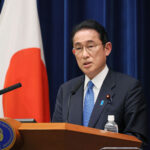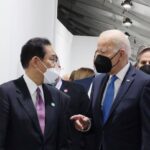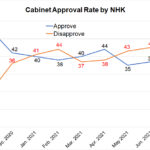The regular Diet session closed on June 23, 2025, and the election was announced on July 3. Debates will unfold over measures to combat rising prices and the consumption tax cut. Of the 248 seats in the Upper House, 125 are up for grabs. In order for the ruling party to have a majority in the Upper House, the Liberal Democratic Party (LDP) and Komeito will need to win at least 50 seats, adding to the 75 they hold that are not up for grabs this election.
The LDP suffered a major defeat in the Lower House election on October 27 last year due to a political funding scandal, so they will be running as a minority ruling party. The issues expected to dominate the election are high prices, which have been a noticeable issue since 2022 and continue to this day; rice shortages; and social security. The LDP also lost the Tokyo Metropolitan Assembly election on June 22, 2025 just before the Upper House election. Furthermore, the LDP’s pledge of cash transfers as a price control measure just prior to the Upper House election has not been well received. On June 30, NHK (Japan Broadcasting Corporation) reported that the cabinet approval rate had dropped from 39% to 34% among those who approved and from 42% to 46% among those who disapproved since the previous report on June 9.
On July 1, just before the Upper House election announcement, President Trump expressed dissatisfaction with trade with Japan, calling it unfair and suggesting raising tariffs on Japanese goods by 30% or 35%. If this were to happen, it would be inevitable that Japan’s automobile industry, which is the backbone of the country, would be greatly affected. Even during the election period, the election issues could change, and some of the election pledges, such as those described below, could be blown away.
On the same day, July 1, it was reported that, according to the Ministry of Finance, tax revenues for fiscal year 2024 (April 2024 to March 2025) are expected to reach a record high of 75.2 trillion yen for the fifth consecutive year. This was an “upswing” of about 1.8 trillion yen from the forecast for November 2023. This increase was due to the strong performance of companies. Corporate taxes increased by 2 trillion yen from the previous fiscal year, reaching 17.9 trillion yen — the highest level since 18.4 trillion yen was recorded during the bubble economy in fiscal 1990. Additionally, consumption tax increased by 1.9 trillion yen, reaching 25 trillion yen, due to increased consumption and imports.
Measures to prevent high prices
The LDP announced an election pledge to allocate the additional tax revenue of about 1.8 trillion yen from this upswing to provide 40,000 yen to children and adults in households not subject to resident tax and 20,000 yen to everyone else. The goal is to achieve a 1% real wage increase and a 3% nominal wage increase, as well as increase wages by approximately 1 million yen by fiscal year 2030 (according to a June announcement by the Japanese Trade Union Confederation [Rengo], the average wage increase rate is 5.26%). Disparities between regions and between regular and non-regular employment will be corrected, and transitioning to regular employment will be promoted. To address the rice shortage, the government plans to strengthen the agricultural production base, increase farmers’ incomes, and establish a comprehensive stockpiling system through collaboration between the public and private sectors to ensure stable supplies and smooth distribution.

On June 23, 2025, following the closing of the regular Diet session, Prime Minister Ishiba Shigeru held a press conference in which he said the following: “Grounded in the discussions held during this Diet session, and with a view to realizing a Japan where people can feel tangibly that tomorrow will be better than today, we will work to raise Japan’s nominal gross domestic product from 600 trillion yen at present to 1,000 trillion yen by 2040. We will also aim to increase the average income, which currently stands at 4 million yen, by more than 50 percent by that time.” PHOTO: CABINET PUBLIC AFFAIRS OFFICE
Although opposition parties are calling for a consumption tax cut, the LDP is opposed, arguing that the Democratic Party of Japan’s Noda Yoshihiko administration and the LDP and Komeito agreed in 2012 to integrate social security and tax reform (raising the consumption tax from 5% to 10% to fund social security). The LDP argues that it would take six months to a year to update the systems of the distribution and retail industries if the consumption tax cut advocated by the opposition parties were to be implemented. This would require personnel and incur costs. Therefore, the LDP claims that a consumption tax cut is an inappropriate economic measure that lacks immediate effects.
In response, the largest opposition party, the Constitutional Democratic Party of Japan (CDPJ), announced that it will set the consumption tax on food at 0% for one year and will not issue deficit bonds to fund this measure. Instead, it will use funds from accumulated reserves and special tax measures. The CDPJ also aims to provide 20,000 yen per person to support people’s livelihoods. The CDPJ also calls for protecting the agriculture, forestry, and fisheries industries by providing subsidies to farmers who maintain their farmland and promoting measures to attract new farmers.
Other major party pledges include raising basic deductions and other amounts in line with price increases to reduce the income tax burden (Komeito); setting the consumption tax on food at 0% for two years, then unifying it at 8% in the medium to long term (Japan Innovation Party [JIP]); and increasing take-home pay and raising the minimum income tax line to 1.78 million yen using revenue increases and expenditure reviews (Democratic Party For the People [DPP]); reducing the consumption tax to 5%; and carrying out tax reforms that require large corporations and the wealthy to pay their fair share, with the aim of abolishing the consumption tax (Japanese Communist Party).
According to the NHK poll as of June 30, the party support rates were 30.8% for the ruling coalition (LDP: 27.0%, Komeito: 3.8%), 26.1% for the opposition parties (CDPJ: 8.4%, DPP: 5.8%, and JIP: 2.1%, etc.), 10.8% for those who did not know or did not answer, and 32.4% for independents. The voting behavior of this group, which makes up 43.2%, will greatly affect the outcome.
Will the ruling party win a majority in the Upper House and continue their current deliberations and policy cooperation, or will they become a minority ruling party in the Upper House? Voting will take place on July 20, and the votes will be counted that same day.
Sano Kentaro is a freelance writer.








